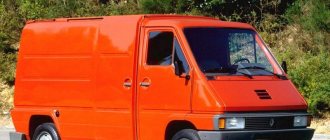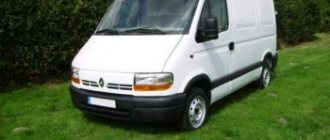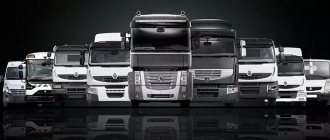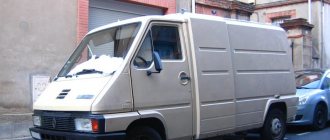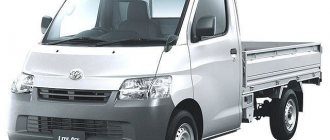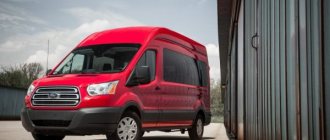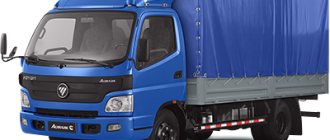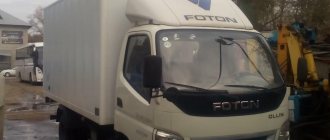- Story
- Characteristics
- Reviews
- Engine and gearbox
- Video
The first generation of Renault Mascotte (French mascotte - bringing good luck), with square headlights and an engine capacity of 2.8 liters.
A representative of the impressive family of compact French trucks, Renault Mascot recently ceased mass production, giving way to a new product from Renault Trucks - Renault Master 3. The car was created on the basis of the first generation Renault Master for the planned replacement of the Renault Messenger model. Over its short life, this practical car, which looks similar to domestic representatives of this class, trucks like the Gazelle or Bychka, has earned positive reviews and great popularity in Russia. This was facilitated by the positive ratio of high quality and reasonable prices, as well as a large selection of used trucks - the popularity of used Renault Mascot confirms that the car’s fame is not accidental.
Review of the Renault Mascott truck
Renault Mascotte is a representative of the French-made family of small trucks, which has proven itself from the very first weeks of production. The first model was released back in 2004 - then the previously popular predecessor Renault Master, known for its reliability and practicality in operation, was taken as a basis. Noting the configuration and type of vehicle, there is no doubt that its task is to transport small-sized cargo over medium and long distances.
Mascott-2
In 2004, the car underwent restyling. Take a look at what the second generation Renault Mascott looks like.
The design of the car was very reminiscent of the Renault Master 2 Series. Unlike the first generation, the new Mascot has more rounded optics, a different radiator grille and bumper. It is still not painted in body color (however, like the mirrors, which have not changed in shape). On the side there are practically no differences between the first and second generations - even the turn signal repeaters are located at the same level. The Renault Mascot truck was produced in this form until 2010. During this time, the manufacturer did not make changes to the design of the machine.
Reviews note the good corrosion resistance of the metal. Even after winter use, the body remains intact. However, this only applies to trucks. For minibuses, problem areas are the sills and the bottom of the rear doors. If the metal is damaged, pockets of corrosion immediately spread. In its original paint, the car does not rust for a long time.
Story
As previously mentioned, the first cars of the Renault Mascott series began to be produced in 2004, although development began in May 1999. In many ways, the car resembled the second series of Master model trucks. This gave rise to debate about which car is better and whether there is any difference between them at all. Looking at the characteristics of these cars, you can see differences in the chassis, engine, grille and other components.
The first models released were equipped with a 2.8-liter diesel engine, which was immediately loved by car enthusiasts. Even now, many say that the first engines produced for Renault Mascotte were the most reliable and resistant to difficult operating conditions. The next version of the car came out with a 3-liter engine with two power configurations, namely 115 hp. and 156 hp In addition to the technical part, the changes also affected the design. The car received rounded headlights instead of the rectangular shape in the previous version.
The latest changes were introduced already in 2007, when the developers placed special emphasis on engine modernization. Now Mascott went on sale in more powerful engine variations: 130 and 150 hp. Changes also affected the frame structure, which provided an increase in load capacity. In the new version of Renault, a direct fuel injection system was used for the first time, which significantly improved the stability of the car when driving over long distances.
General acquaintance
This truck first appeared in May 1999. At that time, the French manufacturer produced only a few commercial vehicles. These are Renault Master and Messenger. Renault Mascott became the successor to the Messenger. At the same time, the car had a similar appearance to the “Master”.
Nevertheless, the car gained great popularity not only in the domestic market, in France, but also far beyond its borders. Serial production of the Renault Mascott ceased in 2010. However, the car is still actively used by Russian carriers.
Modifications
Cars of the brand went on sale in different wheelbase configurations: 4630 mm, 3630 mm, 3130 mm and 4130 mm. Depending on the variation of the car, the weight is from 3.5 tons to 6.5 tons. The Renault Mascott car chassis is designed to lift loads up to 4.5 tons. There were different modifications of cars on sale: both with a single cabin and with a double one.
The car was notable for the fact that it could be used for different purposes. For example, certain configurations of cars were used as timber trucks, minibuses, fire trucks, vans for transporting livestock and other tasks. The car was multifunctional and was used in those areas where the maximum benefit could be obtained from it.
Review of Renault UH04 (2008)
I want to write about my truck, before purchasing which I didn’t even know about its existence. Renault Mascot 2008 3.0 DXi. I bought it after looking at one from a friend. I have been involved in transportation for more than fifteen years and during this time, unfortunately, it has become increasingly difficult to work in this market segment. Therefore, having owned full-fledged trucks, I decided to switch to small-tonnage ones. And so I became the owner of this Renault MASCOTT car, unknown in Russia (which, by the way, belongs to the Renault Truck group according to French documentation) category B! Which is very important for a driver working in cities because... signs prohibiting the movement of cargo transport. are not an obstacle. I can imagine how much I saved on fines in three years! But excuse me, I digress from the car itself, as it is.
My Renault, probably like most, came to me from Poland, and this is probably its main drawback, because... Apparently the car was given attention only before the sale. Therefore, before starting operation, we had to correct what had accumulated, namely: problems with SERV signaling devices, wiring, neglected calipers, play in the kingpins (the most expensive item, but original), cardan cross, drive belt, etc. i.e. consumables. When I encountered such a “big maintenance”, I was surprised by the expensive price of the kingpin and at first I was even upset, but then I calmed down due to the quite reasonable prices for everything else. Accordingly, having studied the device, I saw its simplicity and reliability, there was not even a catalyst that could clog. There was nothing more than natural.
After the preparation for operation was completed, work began for three years under 3 tons of cargo with regular maintenance every 15,000 km. In general, at first there was anxiety from expecting surprises, but nothing bad happened. The only thing is probably that I had to get used to the peculiar sound of the muffler (something similar to the Gazelle or Volgotaxi) and sometimes the knock that appears from the box in neutral in static conditions (as the gearbox gurus explained, this is a ZF feature that you just need to get used to, if not desire to buy a new box).
So, somehow I wound almost one hundred and fifty thousand on the speedometer. Yes, and you need to keep an eye on the fuel filter and buy the one that is more expensive, otherwise on the cheapest ones the fuel shortage signal comes on much earlier. The horrors about the Nissan engine did not come true; apparently, before introducing it into Mascot, the engineers tried to deprive it of the shortcomings that appeared in the Patrols. In general, this model is the development of Volvo Truck engineers, and they probably know a lot about such designers.
Renault Mascott cabin interior
The interior of the car is another important criterion that deserves special attention. Looking at the interior, it is impossible to single out any notable elements in terms of design. The series of cars itself does not imply an emphasis on any design solutions inside the cabin. The driver's cabin is made as simple as possible, but this simplicity can only be attributed to the number of advantages.
When sitting in such a cabin, the driver has free access to all controls. Renault Mascotte chairs are made of high-quality material, all the upholstery in the cabin does not have any unnecessary gaps. The developers have placed special emphasis on simplicity, but at the same time, there is no feeling of cheapness inside the cabin, all compartments, glove compartments, and pockets do not emit any unnecessary creaks, everything works as smoothly as possible.
The cabin includes 2 driver's seats, both seats can be adjusted from height to angle of inclination. The strengths of the car interior also include the use of high-quality sound insulation. Even during intense driving, the driver will feel complete comfort from driving, since no extraneous noise will distract him from the process itself. The standard equipment of the car includes climate control, making the ride even more comfortable. The car is fully adapted to driving in adverse weather conditions, which is why it is in great demand among buyers.
Salon
The truck's interior is both modest and ergonomic. A distinctive feature of the Renault Mascot is the special location of the gearbox. It is at panel level and not in the floor. This significantly saves cabin space.
The center console contains a tachograph (since this is a light-duty truck with increased payload), a heater control unit, a radio, and a pair of air vents. Below there is an alarm button and a small niche for documents. The steering wheel is three-spoke, without additional remote control buttons. The instrument panel includes all the necessary scales, as well as an on-board computer that shows fuel consumption, errors and other useful information.
On the left side of the driver there is a power window control unit. On the passenger side you can see a spacious glove compartment. There is another niche above it. The seats of the Renault Mascot are quite comfortable, as noted by reviews. They are equipped with torsion bar suspension and have a separate stiffness regulator with a weight scale. There is also an armrest. Over long distances, the back does not become stiff, which is very important for the driver of such a vehicle. Regardless of what configuration the Renault Mascott had, the car was equipped from the factory with hydraulic power steering.
The owners are very pleased with the presence of many pockets and niches in the cabin. After all, commercial vehicles have to carry a lot of accompanying documentation. In this regard, the interior of the French Mascot truck is thought out very well, as noted by reviews. The only drawback in the interior is that the plastic is too hard. But even with it, the level of sound insulation is high.
Engine and gearbox
The heart of any car is undoubtedly the engine, and special attention has always been paid to this here. The Renault Mascott car series was produced in two engine variations: 6-cylinder and 4-cylinder. As the series developed, the engine power increased - this was done to improve operational capabilities and increase the maximum load of the car.
Main engine variations:
- 130 hp – the number of revolutions during operation reaches 3600 min−1 (300 Nm);
- 150 hp - the number of revolutions during operation reaches 3600 min-1 (350 Nm).
The gearbox could differ in different model series. Initially, a 5-speed manual gearbox was taken as the basis. After several stages of modernization of the Renault Mascott, the developers decided to replace it with a more advanced 6-speed gearbox, the range of which was much wider. Such changes in the design of the gearbox have reduced fuel consumption and significantly improved the car's performance at low speeds.
Specifications
The car was equipped with different power units. The youngest in the line is a 4-cylinder diesel engine with 86 horsepower. This engine was installed on short minibuses. The next in the line is also a turbocharged diesel engine from SOFIM (these were installed on Iveco Daily and Fiat Ducato).
With its volume of 2.8 liters (the same as the previous version), it produced 125 horsepower. What is noteworthy is that all power units were constantly refined during production. So, by the end of production, the Renault Mascot was equipped with a 2.8-liter engine with 146 horsepower.
Chassis (suspension, brakes, steering)
Getting closer to the technical part, you should start with the vehicle's suspension, which is a fundamental element when choosing small vans. In this case, it should be noted that the seating position is quite high, which is perfect for our roads. The use of such a suspension on a Renault Mascott makes it possible to safely transport cargo on poor-quality road sections, while minimizing the threat of breakdown.
The entire line of cars has always meant the use of disc brakes on all four wheels. This was done solely for reasons of road safety. A significant role in this was played by the use of components such as the electro-hydraulic system, anti-lock braking system and traction control. All these elements allow you to improve grip on the road surface and quickly stop the car in an emergency.
The presence of power steering in Mascott is another element that allows you to make the ride as comfortable as possible. The car boasts excellent steering, well-adjusted hydraulic shock absorbers and high-quality air suspension.
Equipment:
- Power steering;
- Suspension stabilizers;
- Hydraulic shock absorbers on both sides;
- Air suspension;
- Battery capacity 12V, 105Ah;
- Dimensions of the body part (from 2575 mm to 6460);
- Climate control.
Disadvantages of Renault Mascott
One of the main disadvantages of a car is considered to be the selection of spare parts and repairs. Very often minor breakdowns occur involving bearings, belts, handbrake, turbines and other elements. At the same time, the spare parts market cannot be called truly extensive. Sometimes you have to wait for the moment to buy some simple part.
Over the long term, Renault shows itself exclusively on the positive side. The main thing is to periodically change parts that have begun to wear out. If you do everything in advance, there will be no urgent need to select spare parts.
Prices for Renault Mascott
This criterion very much depends on what kind of configuration we are talking about, what condition the car is in, what year it was made, and so on. If we take the average figure on the used car market, the figure is around 6-10 thousand dollars. The price is completely inaccurate: this means that a 2006 model in good condition will cost $13,000, while the old 2004 configuration will cost somewhere around 4,000. It is best to look at the sales advertisements yourself in order to better study the market assortment and all the interesting offers.
Based on all of the above, we can conclude that the vans in the series are well worth their price and are still quite suitable for active use. Despite the presence of more advanced models of the brand, the Renault Mascott series still demonstrates a high level of reliability and is able to compete with newer and more expensive cars.
Maneuverable and practical Renault Mascott, like a light truck
The interior of the Renault Mascott is reminiscent of the Master. When entering the cabin, you can note a step-platform with an anti-slip coating. This contributes to driver safety and comfort. Inside the cabin, the trip computer is clearly visible in the middle of the front and there is plenty of storage space for small items, making everyday use easier. The large exterior mirror provides additional safety with ample visibility.
The vehicle is constructed from lightweight aluminum and panels, and the 500kg capacity loading lift features hydraulically extendable legs that make loading and unloading the vehicle much easier, stabilizing the rear of the vehicle to prevent potential rollovers.
The 2295 mm version of the Renault Mascott light truck is relatively narrow and maneuverable. Driving through narrow streets is not a problem for him.
Loud, but with a comfortable suspension
The Loaded Mascott rides stable thanks to its durable, rigid suspension. It is equipped with single parabolic springs at the front and double parabolic springs at the rear, which combine adequate rigidity and a comfortable ride.
The Mascott is not like the Iveco Daily, which is equipped with air suspension. By shifting to sixth gear, it is possible to accelerate on national roads and highways, reaching an average of 85 km/h. When the accelerator pedal is depressed, the car becomes quite loud, generating 71 dB.
Renault Mascott - an alternative to the 7.5 t car
The Renault Mascott is often an alternative to the 7.5 tonne vehicle due to its six-speed gearbox, especially when it has the same payload. For enterprises providing courier services, it is advisable to consider modifications with a closed container body. It is spacious enough for a large number of packages of goods. The rear of a Renault Mascott van is easier to load than trucks.
Currently, prices for Renault Mascott vehicles range from 590,000 to 1,000,000 rubles. These cars rolled off the assembly line from 1999 to 2010, and therefore, if interested in this modification, the consumer will only be able to purchase a used car.
Design
The car has a half-hood layout, where the engine is slightly “recessed” into the cabin. Renault Mascott has never been distinguished by its sophisticated design forms.
After all, this is a working car, and it should have advantages in completely different ways. Note that the French truck was produced in two generations. The first was mass-produced from 1999 to 2004. The car had the same design as in the photo above. A large unpainted bumper, two-piece optics and a huge glass area are all features of the Renault Mascott commercial vehicle. Owner reviews note that the car has a comfortable fit, which is ensured by the footrest. Drivers also praised the Mascot for its large and informative mirrors.
